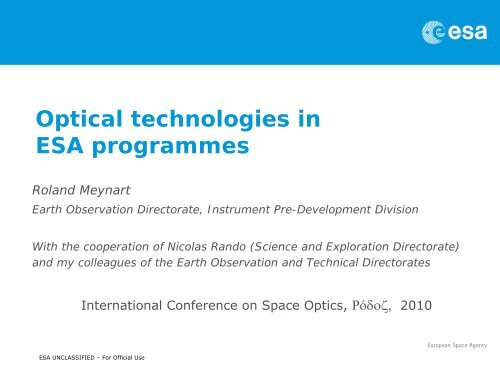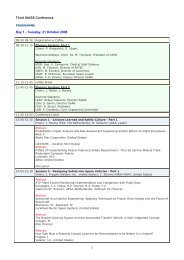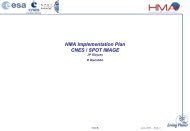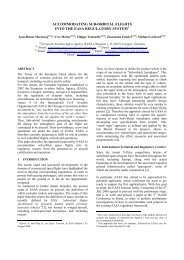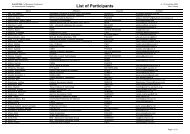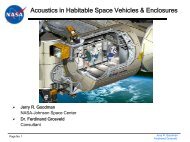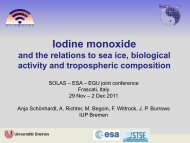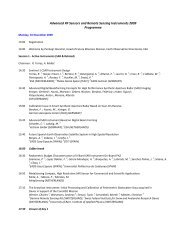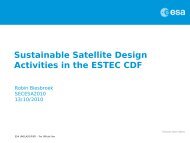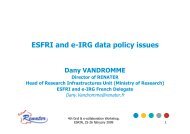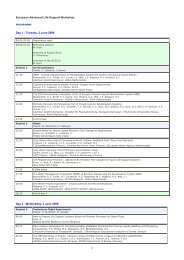Optical technologies in ESA programmes - Congrex
Optical technologies in ESA programmes - Congrex
Optical technologies in ESA programmes - Congrex
You also want an ePaper? Increase the reach of your titles
YUMPU automatically turns print PDFs into web optimized ePapers that Google loves.
<strong>Optical</strong> <strong>technologies</strong> <strong>in</strong><br />
<strong>ESA</strong> <strong>programmes</strong><br />
Roland Meynart<br />
Earth Observation Directorate, Instrument Pre-Development Division<br />
With the cooperation of Nicolas Rando (Science and Exploration Directorate)<br />
and my colleagues of the Earth Observation and Technical Directorates<br />
International Conference on Space Optics, �ό����<br />
<strong>ESA</strong> UNCLASSIFIED – For Official Use<br />
2010
What is space optics?<br />
1.<br />
2.<br />
3.<br />
What is optics?<br />
a.<br />
From �-rays to mm-wave<br />
–<br />
–<br />
What is it good for ?<br />
a.<br />
b.<br />
c.<br />
d.<br />
e.<br />
f.<br />
About �=100 GHz (quasi-optics !)<br />
Practically (here) �<br />
Earth Observation<br />
Space Science<br />
Exploration<br />
Microgravity research<br />
Communications<br />
Spacecraft avionics<br />
Focus of this talk on large systems<br />
Optics <strong>in</strong> <strong>ESA</strong> <strong>programmes</strong> | Roland Meynart | ICSO �ό��� 2010 | 05 October 2010 | Earth Observation | Slide 2<br />
≈<br />
100-200 �m
Payload: What do we need ?<br />
Example: Planetary imag<strong>in</strong>g spectrometer<br />
Satellite motion<br />
Re-imag<strong>in</strong>g<br />
lens<br />
x<br />
2D array detector<br />
Dispers<strong>in</strong>g element<br />
Collimator<br />
Telescope<br />
Ground swath<br />
Optics <strong>in</strong> <strong>ESA</strong> <strong>programmes</strong> | Roland Meynart | ICSO �ό��� 2010 | 05 October 2010 | Earth Observation | Slide 3<br />
�<br />
Slit<br />
Baffle
–<br />
Optics for Space (1)<br />
Not new of course, started with<br />
a.<br />
ground-based astronomy and astrometry<br />
Optics <strong>in</strong> <strong>ESA</strong> <strong>programmes</strong> | Roland Meynart | ICSO �ό��� 2010 | 05 October 2010 | Earth Observation | Slide 4
–<br />
Optics for Space (2)<br />
Not new of course, started with<br />
b.<br />
Accuracy ≈ 5-10 arcsec<br />
Astrometry for navigation<br />
Optics <strong>in</strong> <strong>ESA</strong> <strong>programmes</strong> | Roland Meynart | ICSO �ό��� 2010 | 05 October 2010 | Earth Observation | Slide 5<br />
© National Maritime<br />
Museum, Greenwich
A typical (almost) complete space system<br />
The ultimate astrometry mission: GAIA<br />
F<strong>in</strong>al “catalogue” accuracy: 300 microarcsec<br />
It does astrometry, photometry and spectroscopy<br />
Optics <strong>in</strong> <strong>ESA</strong> <strong>programmes</strong> | Roland Meynart | ICSO �ό��� 2010 | 05 October 2010 | Earth Observation | Slide 6
GAIA (2)<br />
1.<br />
High-stability structures – Advanced materials<br />
Optics <strong>in</strong> <strong>ESA</strong> <strong>programmes</strong> | Roland Meynart | ICSO �ό��� 2010 | 05 October 2010 | Earth Observation | Slide 7
2.<br />
3.<br />
4.<br />
5.<br />
GAIA (3)<br />
Large detector array of arrays (106!), with<br />
advanced functionality<br />
Large high-accuracy mirrors<br />
Dispersive spectrometer<br />
Thermal control (shade!)<br />
What’s miss<strong>in</strong>g ?<br />
Optics <strong>in</strong> <strong>ESA</strong> <strong>programmes</strong> | Roland Meynart | ICSO �ό��� 2010 | 05 October 2010 | Earth Observation | Slide 8
The <strong>ESA</strong> Science Programme<br />
“Cosmic Vision”<br />
Optics <strong>in</strong> <strong>ESA</strong> <strong>programmes</strong> | Roland Meynart | ICSO �ό��� 2010 | 05 October 2010 | Earth Observation | Slide 9
The Cosmic vision themes (1)<br />
Optics <strong>in</strong> <strong>ESA</strong> <strong>programmes</strong> | Roland Meynart | ICSO �ό��� 2010 | 05 October 2010 | Earth Observation | Slide 10
The Cosmic vision themes (2)<br />
Optics <strong>in</strong> <strong>ESA</strong> <strong>programmes</strong> | Roland Meynart | ICSO �ό��� 2010 | 05 October 2010 | Earth Observation | Slide 11
The Cosmic vision themes (3)<br />
Optics <strong>in</strong> <strong>ESA</strong> <strong>programmes</strong> | Roland Meynart | ICSO �ό��� 2010 | 05 October 2010 | Earth Observation | Slide 12
The Cosmic vision themes (4)<br />
Optics <strong>in</strong> <strong>ESA</strong> <strong>programmes</strong> | Roland Meynart | ICSO �ό��� 2010 | 05 October 2010 | Earth Observation | Slide 13
Cosmic Vision Implementation<br />
1.<br />
2.<br />
3.<br />
4.<br />
5.<br />
Space Science Programme<br />
a.<br />
b.<br />
c.<br />
Exist<strong>in</strong>g missions<br />
–<br />
<strong>in</strong>cludes<br />
Herschel, Planck lately<br />
Missions <strong>in</strong> development<br />
–<br />
LISA PF, Bepi<br />
Colombo, GAIA, JWST<br />
New MediumandLargecandidate missions <strong>in</strong> “Cosmic<br />
Vision 2015-2025”<br />
Space Sciences missions “enjoys”<br />
long preparation efforts<br />
<strong>ESA</strong> funds/develops space <strong>in</strong>frastructure (satellite, telescope)<br />
Instruments are generally provided by Institutes, funded by Member<br />
States, with few exceptions:<br />
a.<br />
GAIA (no <strong>in</strong>strument �)<br />
b. NIRSPEC (JWST)<br />
Cooperation with NASA traditional<br />
Optics <strong>in</strong> <strong>ESA</strong> <strong>programmes</strong> | Roland Meynart | ICSO �ό��� 2010 | 05 October 2010 | Earth Observation | Slide 14
Cosmic Vision schedule<br />
Optics <strong>in</strong> <strong>ESA</strong> <strong>programmes</strong> | Roland Meynart | ICSO �ό��� 2010 | 05 October 2010 | Earth Observation | Slide 15
Bepi Colombo (1)<br />
1.<br />
2.<br />
3.<br />
Just like a Earth Observation Mission, but a bit more difficult<br />
The problem is not just to get there but also to survive<br />
But we know much less on Mercury than on the Earth, so<br />
<strong>in</strong>struments are “easy”<br />
Optics <strong>in</strong> <strong>ESA</strong> <strong>programmes</strong> | Roland Meynart | ICSO �ό��� 2010 | 05 October 2010 | Earth Observation | Slide 16
BepiColombo (2)<br />
Spacecraft<br />
Mercury<br />
Planetary<br />
Orbiter (MPO)<br />
Mercury<br />
Magnetospheric<br />
Orbiter (MMO)<br />
Stabilisation 3-axis stabilised 15-rpm sp<strong>in</strong>-stabilised<br />
Orientation Nadir Sp<strong>in</strong> axis at 90° to Sun<br />
Spacecraft Mass 520 kg 250 kg<br />
Payload Mass 60 kg 47 kg<br />
Power 600 W 325 W<br />
TM band X/Ka-band X-band<br />
Deployment 400 × 1508 km 400 × 11 824 km<br />
Operational lifetime > 1 year > 1 year<br />
Data volume 1550 Gb/year 160 Gb/year<br />
Equivalent average data rate 50 kb/s 5 kb/s<br />
Antenna High-temperature resistant 1.0 m<br />
X/Ka-band high-ga<strong>in</strong> steerable<br />
antenna<br />
Thrusters Gridded ion thrusters<br />
Optics <strong>in</strong> <strong>ESA</strong> <strong>programmes</strong> | Roland Meynart | ICSO �ό��� 2010 | 05 October 2010 | Earth Observation | Slide 17<br />
0.8 m X-band phased array highga<strong>in</strong><br />
antenna<br />
Other equipment high temperature resistant thermal protection, solar arrays
BepiColombo (3): some <strong>in</strong>struments<br />
BELA<br />
– 20 cm lightweight telescope<br />
– High sensitive (low noise) APD detector<br />
– 50mJ, 3ns diode pumped Nd:YAG laser, 10Hz<br />
nom<strong>in</strong>al repetition<br />
MERTIS<br />
– 10 cm TMA telescope<br />
– Offner spectrometer (7-14 �m) Uncooled<br />
array<br />
– Thermoelectric array (7-40 �m)<br />
Optics <strong>in</strong> <strong>ESA</strong> <strong>programmes</strong> | Roland Meynart | ICSO �ό��� 2010 | 05 October 2010 | Earth Observation | Slide 18<br />
bolometer
JWST – NIRSPEC (1)<br />
Optics <strong>in</strong> <strong>ESA</strong> <strong>programmes</strong> | Roland Meynart | ICSO �ό��� 2010 | 05 October 2010 | Earth Observation | Slide 19
Camera TMA<br />
JWST – NIRSPEC (2)<br />
Collimator TMA<br />
Coupl<strong>in</strong>g Optics (with<br />
Pick-off mirror<br />
underneath)<br />
Filter Wheel<br />
Micro Shutter<br />
Array<br />
Focal Plane<br />
Integral<br />
Assembly Fold Field Unit Calibration<br />
Mirror<br />
Assembly<br />
Re-focus<br />
Mechanism<br />
Calibration<br />
Mirror 2<br />
FORE Optics<br />
TMA<br />
Calibration<br />
Mirror 1<br />
Optics <strong>in</strong> <strong>ESA</strong> <strong>programmes</strong> | Roland Meynart | ICSO �ό��� 2010 | 05 October 2010 | Earth Observation | Slide 20
JWST – NIRSPEC (3): detectors and<br />
micro-shutters<br />
Optics <strong>in</strong> <strong>ESA</strong> <strong>programmes</strong> | Roland Meynart | ICSO �ό��� 2010 | 05 October 2010 | Earth Observation | Slide 21
COSMIC VISION 2015-2025<br />
Successive down-selection of Land M-class missions<br />
Optics <strong>in</strong> <strong>ESA</strong> <strong>programmes</strong> | Roland Meynart | ICSO �ό��� 2010 | 05 October 2010 | Earth Observation | Slide 22
COSMIC VISION 2015-2025<br />
Optics <strong>in</strong> <strong>ESA</strong> <strong>programmes</strong> | Roland Meynart | ICSO �ό��� 2010 | 05 October 2010 | Earth Observation | Slide 23
IXO – International X-ray Observatory<br />
Optics <strong>in</strong> <strong>ESA</strong> <strong>programmes</strong> | Roland Meynart | ICSO �ό��� 2010 | 05 October 2010 | Earth Observation | Slide 24
-<br />
-<br />
�<br />
IXO summary<br />
New generation x-ray observatory (3.5 m2 at 1.5 keV, 0.65 m2 6.5 keV).<br />
at<br />
Agreement by <strong>ESA</strong>, JAXA and NASA as framework for all activities:<br />
•<br />
•<br />
•<br />
•<br />
A s<strong>in</strong>gle large X-ray mirror assembly compatible with both<br />
pore optics and slumped glass technology.<br />
An extensible optical bench to reach F = 20 to 25m, plus<br />
ways to maximise Aeff above 6 keV.<br />
Instruments <strong>in</strong>clude a wide field imager (WFI), Hard x-ray<br />
Camera (HXI), a non-dispersive imag<strong>in</strong>g spectrometer<br />
(XMS), an X-ray grat<strong>in</strong>g spectrometer (XGS), High Time<br />
Resolution Spectrometer (HTRS), X-ray Polarimeter (XPOL).<br />
IXO concept compatible with Ariane<br />
5 and Atlas V 551<br />
IXO concept <strong>in</strong>put to US decadal survey and <strong>ESA</strong> Cosmic Vision<br />
selection process<br />
Optics <strong>in</strong> <strong>ESA</strong> <strong>programmes</strong> | Roland Meynart | ICSO �ό��� 2010 | 05 October 2010 | Earth Observation | Slide 25
-<br />
-<br />
-<br />
-<br />
Instruments assessment studies<br />
Request for Declaration of Intents (DOI) released by <strong>ESA</strong> <strong>in</strong> 2009.<br />
7 DOI’s were received from correspond<strong>in</strong>g <strong>in</strong>strument consortia:<br />
•<br />
•<br />
•<br />
•<br />
•<br />
•<br />
•<br />
XMS –<br />
WFI –<br />
HTRS –<br />
HXI –<br />
XPOL –<br />
SRON<br />
MPE<br />
OP-XGS –<br />
CESR/CNES<br />
JAXA/ISAS/CEA<br />
INFN<br />
OU<br />
Si-μcalorimeters –<br />
CEA<br />
7 studies have been kicked-off (CAT-XGS under discussion with<br />
MIT/NASA).<br />
Assessment activities <strong>in</strong> parallel with system level studies.<br />
Optics <strong>in</strong> <strong>ESA</strong> <strong>programmes</strong> | Roland Meynart | ICSO �ό��� 2010 | 05 October 2010 | Earth Observation | Slide 26
Critical areas (<strong>ESA</strong> and national)<br />
Optics <strong>in</strong> <strong>ESA</strong> <strong>programmes</strong> | Roland Meynart | ICSO �ό��� 2010 | 05 October 2010 | Earth Observation | Slide 27
OPTICS:<br />
1.<br />
<strong>ESA</strong> has selected the Silicon Pore Optics as the<br />
basel<strong>in</strong>e mirror technology <strong>in</strong> its IXO development plan<br />
for 2008-2012 (req. HEW < 5 arcsec at 1.25 keV).<br />
2. Encourag<strong>in</strong>g results from Silicon Pore X-ray Optics:<br />
S<strong>in</strong>gle reflection HEW = 7 arcsec obta<strong>in</strong>ed from stack of 10<br />
plates (out of 45).<br />
CRYO-CHAIN:<br />
1. Maxi compressor (advanced l<strong>in</strong>ear compressor for e.g.<br />
10K cooler) TRP activity is runn<strong>in</strong>g with Astrium & RAL<br />
s<strong>in</strong>ce 2 years, 1 more year to go.<br />
2. 10K Stirl<strong>in</strong>g cooler (l<strong>in</strong>ked to previous activity) is runn<strong>in</strong>g<br />
with Astrium & RAL s<strong>in</strong>ce 2 years, 1 year to go.<br />
3.<br />
IXO technology - <strong>ESA</strong> funded<br />
The 50mK cooler development activity with CEA to<br />
develop sorption/ADR cooler comb<strong>in</strong>ation is runn<strong>in</strong>g s<strong>in</strong>ce<br />
Jan 2008 for a 24 months duration.<br />
Optics <strong>in</strong> <strong>ESA</strong> <strong>programmes</strong> | Roland Meynart | ICSO �ό��� 2010 | 05 October 2010 | Earth Observation | Slide 28
LISA – Laser Interferometer Space Antenna<br />
Optics <strong>in</strong> <strong>ESA</strong> <strong>programmes</strong> | Roland Meynart | ICSO �ό��� 2010 | 05 October 2010 | Earth Observation | Slide 29
1.<br />
•<br />
•<br />
•<br />
•<br />
2.<br />
–<br />
LISA - Overview<br />
<strong>ESA</strong>/NASA collaboration.<br />
Measurement of gravitational wave us<strong>in</strong>g laser <strong>in</strong>terferometry.<br />
Constellation of 3 spacecrafts separated by 5 million km.<br />
Interferometric measurements of variations <strong>in</strong> distance<br />
between couples of test masses at pico-metre level.<br />
LISA Pathf<strong>in</strong>der technology validation mission.<br />
Mission Formulation activities<br />
LISA recent activities dom<strong>in</strong>ated by support to the Astronomy and<br />
Astrophysics Decadal Survey (Astro2010) of the US National<br />
Academy of Sciences.<br />
Optics <strong>in</strong> <strong>ESA</strong> <strong>programmes</strong> | Roland Meynart | ICSO �ό��� 2010 | 05 October 2010 | Earth Observation | Slide 30
1.<br />
2.<br />
3.<br />
4.<br />
5.<br />
6.<br />
7.<br />
8.<br />
LISA – Critical areas<br />
Low-noise, high stability mechanisms (po<strong>in</strong>t-ahead and optical<br />
articulation).<br />
Highly stable materials for telescope assembly (CFRP,<br />
zerodur, <strong>in</strong>serts …).<br />
Low-noise electronic components for GRS front-end<br />
electronics (voltage references ..).<br />
Light sources for charge management discharge (LED’s, laser<br />
diodes …).<br />
Metrology system.<br />
High-power laser system (1-2 W EOL, redundant)<br />
Out-gass<strong>in</strong>g & contam<strong>in</strong>ation issues.<br />
Micro-propulsion (lifetime characterization).<br />
Optics <strong>in</strong> <strong>ESA</strong> <strong>programmes</strong> | Roland Meynart | ICSO �ό��� 2010 | 05 October 2010 | Earth Observation | Slide 31
LAPLACE<br />
Optics <strong>in</strong> <strong>ESA</strong> <strong>programmes</strong> | Roland Meynart | ICSO �ό��� 2010 | 05 October 2010 | Earth Observation | Slide 32
LAPLACE<br />
1.<br />
2.<br />
3.<br />
4.<br />
5.<br />
Jo<strong>in</strong>t NASA-<strong>ESA</strong> outer planet mission to Jovian system<br />
Two spacecraft to perform coord<strong>in</strong>ated observation of Jovian<br />
satellites (Callisto, Ganymede, Europa) and Jupiter’s magnetosphere,<br />
atmosphere and <strong>in</strong>terior.<br />
Jupiter Ganymede Orbiter (JGO): <strong>ESA</strong><br />
Jupiter Europa<br />
Oribiter<br />
(JEO): NASA<br />
Science <strong>in</strong>strumentation shared between NASA and <strong>ESA</strong> Member<br />
States<br />
Optics <strong>in</strong> <strong>ESA</strong> <strong>programmes</strong> | Roland Meynart | ICSO �ό��� 2010 | 05 October 2010 | Earth Observation | Slide 33
LAPLACE (2) JGO Model Payload<br />
Optics <strong>in</strong> <strong>ESA</strong> <strong>programmes</strong> | Roland Meynart | ICSO �ό��� 2010 | 05 October 2010 | Earth Observation | Slide 34
LAPLACE JGO: critical areas<br />
Optics <strong>in</strong> <strong>ESA</strong> <strong>programmes</strong> | Roland Meynart | ICSO �ό��� 2010 | 05 October 2010 | Earth Observation | Slide 35
EUCLID<br />
Optics <strong>in</strong> <strong>ESA</strong> <strong>programmes</strong> | Roland Meynart | ICSO �ό��� 2010 | 05 October 2010 | Earth Observation | Slide 36
Euclid - Mission overview<br />
‘Dark energy’ study via Weak Lens<strong>in</strong>g and BAO techniques.<br />
VIS/NIR imag<strong>in</strong>g survey, NIR spectroscopic survey.<br />
Observe 20.000 deg2 of extragalactic sky at galactic lat |b| ≥<br />
1.<br />
2.<br />
3.<br />
4.<br />
5.<br />
~1.2m dia. Telesc.<br />
Optics <strong>in</strong> <strong>ESA</strong> <strong>programmes</strong> | Roland Meynart | ICSO �ό��� 2010 | 05 October 2010 | Earth Observation | Slide 37<br />
30 o<br />
Step & stare with <strong>in</strong>stantaneous fields of about 0.5 × 1 deg2 . Wide<br />
survey requires about 4 yr.<br />
VIS and NIP with co aligned 1.0° x 0.5° field, 0.1 arcsec VIS pixel<br />
(36 CCDs, 4k x 4k). NIP (18 IR detectors).<br />
NIS channel – basel<strong>in</strong>e as slit-less, 1.0° x 0.5° field, 0.5 as/px.<br />
Hawaii2RG IR detectors with 2.5 �m cut-off (US).
1.<br />
2.<br />
3.<br />
4.<br />
Euclid - Critical areas<br />
Large area focal planes (VIS & NIR) – state of art + radiation<br />
resistance.<br />
Exceptional requirements on PSF stability and low ellipticity<br />
(0.1 arcsec).<br />
Step and stare sky scann<strong>in</strong>g strategy – duty cycle efficiency<br />
and L<strong>in</strong>e of Sight Stability.<br />
Very high data rate – K band required.<br />
Exist<strong>in</strong>g development activities:<br />
1. CCD radiation test<strong>in</strong>g – Euclid mission dose and test the impact<br />
on Euclid specific performance and ops mode.<br />
2. DMD – prequalification activity.<br />
3. Dichroics and feed for ground stations <strong>in</strong> K-band.<br />
4. FGS CCD – system issue for faster readout than the science<br />
sensors. A fast ADC and readout controller is to be developed<br />
for wide range generic applications<br />
5. Cryo-lens material –Manufactur<strong>in</strong>g of refractive IR components<br />
(optical components and mounts), <strong>in</strong>tegration <strong>in</strong> an optical<br />
cha<strong>in</strong>, and test<strong>in</strong>g to demonstrate the opto-mechanical<br />
performances <strong>in</strong> representative environment (cryogenic<br />
temperatures and vibration levels).<br />
6. Mirror CVD & polish<strong>in</strong>g – needed for high quality optical<br />
performance (15nm rms surface)<br />
Optics <strong>in</strong> <strong>ESA</strong> <strong>programmes</strong> | Roland Meynart | ICSO �ό��� 2010 | 05 October 2010 | Earth Observation | Slide 38
Euclid Technology – Nationally<br />
funded<br />
Prelim<strong>in</strong>ary list<br />
1.<br />
2.<br />
3.<br />
4.<br />
Visible Wavelength CCD Pre-Development – optimisation based on basel<strong>in</strong>e<br />
e2v-CCD-203<br />
Cryo-mechanisms -rotation accuracy, filter and optical element dimensions and<br />
masses, operational schedules for exchange speed and total lifetime cycles.<br />
Design & manufacture of prototype grism- 1 to 2 micron range with constant<br />
resolv<strong>in</strong>g power<br />
Verify Teledyne Hawaii array image persistence and irradiation performance<br />
are consistent with EUCLID operational modes<br />
Optics <strong>in</strong> <strong>ESA</strong> <strong>programmes</strong> | Roland Meynart | ICSO �ό��� 2010 | 05 October 2010 | Earth Observation | Slide 39
PLATO<br />
Optics <strong>in</strong> <strong>ESA</strong> <strong>programmes</strong> | Roland Meynart | ICSO �ό��� 2010 | 05 October 2010 | Earth Observation | Slide 40
PLATO – Mission<br />
overview<br />
- To search for exo-planetary transits (occultations) <strong>in</strong> front of stars.<br />
- To characterize the parent stars via astero-seismology.<br />
- High time-resolution, high precision, and high duty-cycle visible photometry.<br />
- L2 - SF 2-1b LV (2146 kg) - Optics and detectors (CCD) at ~170K – 6yr.<br />
Concept 1<br />
•<br />
•<br />
•<br />
•<br />
•<br />
2-mirror optical design, 169 mm pupil / tel.<br />
12-telescopes with two simultaneously observed FoV (4<br />
groups of 3 tel.)<br />
Very large total FoV (~1800 deg² useful) allow<strong>in</strong>g<br />
observ<strong>in</strong>g brighter stars.<br />
~0.15 m 2 collect<strong>in</strong>g area per sub-field.<br />
Full FoV available with rotation every 6 months around the<br />
LoS.<br />
A group of 3 tel.<br />
Symmetry to 180 deg rotation<br />
every 6 months<br />
Optics <strong>in</strong> <strong>ESA</strong> <strong>programmes</strong> | Roland Meynart | ICSO �ό��� 2010 | 05 October 2010 | Earth Observation | Slide 41<br />
6 telescopes<br />
sight<strong>in</strong>g FoV #1<br />
6 telescopes<br />
sight<strong>in</strong>g FoV #2
Concept 2<br />
•<br />
•<br />
•<br />
•<br />
•<br />
PLATO – Mission overview (cont.)<br />
Dioptric system, 6 sph. lenses, 83 mm pupil<br />
54 refractive telescopes mounted <strong>in</strong>dividually on tilted base plate<br />
Total FoV ~625 deg 2 to see cool dwarfs at greater distance with<br />
required SNR<br />
0.3 m2 collect<strong>in</strong>g area<br />
Circular FoV allows for monthly rotation around LoS with<br />
cont<strong>in</strong>uous observation<br />
concept3<br />
Optics <strong>in</strong> <strong>ESA</strong> <strong>programmes</strong> | Roland Meynart | ICSO �ό��� 2010 | 05 October 2010 | Earth Observation | Slide 42<br />
•<br />
•<br />
•<br />
•<br />
•<br />
Dioptric system with 6 lenses (2 aspherical), 115 mm<br />
pupil<br />
42 refractive telescopes mounted <strong>in</strong>dividually on stair<br />
case base plate<br />
Total FoV ~1800 deg2 <strong>in</strong> 4 groups of 10 tel. partially<br />
overlapp<strong>in</strong>g<br />
Needs quarterly rotation due to FPA configuration<br />
Group<strong>in</strong>g of telescopes gives access to large FoV
PLATO Technology – <strong>ESA</strong> funded<br />
Deployable Sunshield Demonstrator<br />
•<br />
•<br />
•<br />
Goal: Design and development of deployable sunshield<br />
demonstrator to be used on PLATO<br />
Requirement: Due to very large field-of-view of<br />
telescopes, Deployable Sunshield needed to avoid<br />
vignett<strong>in</strong>g of telescope field-of-view<br />
Heritage: Based on GAIA deployable sunshield, Holddown<br />
and release mechanism (HDRM) is new<br />
development<br />
Strap<br />
Optics <strong>in</strong> <strong>ESA</strong> <strong>programmes</strong> | Roland Meynart | ICSO �ό��� 2010 | 05 October 2010 | Earth Observation | Slide 43
PLATO TDP – Nationally funded<br />
Prelim<strong>in</strong>ary list<br />
CCD prototyp<strong>in</strong>g (All)<br />
•<br />
•<br />
Goal: Development of PLATO optimized high speed, high<br />
dynamic range CCD (specifications are concept dependant)<br />
Requirement: Due to multi-aperture approach, many CCDs<br />
need to be produced <strong>in</strong> short time frame<br />
Refractive telescope breadboard<br />
•<br />
•<br />
Goal: Bread-board<strong>in</strong>g of a 6 lens telescope, with large diameter<br />
lenses and operat<strong>in</strong>g at low work<strong>in</strong>g temperature<br />
Requirement: Due to 54 telescopes to be produced, heritage<br />
from a bread-board telescope is needed to validate lens<br />
mount<strong>in</strong>g, barrel alignment and perform basic test<strong>in</strong>g<br />
Optics <strong>in</strong> <strong>ESA</strong> <strong>programmes</strong> | Roland Meynart | ICSO �ό��� 2010 | 05 October 2010 | Earth Observation | Slide 44
SPICA<br />
Optics <strong>in</strong> <strong>ESA</strong> <strong>programmes</strong> | Roland Meynart | ICSO �ό��� 2010 | 05 October 2010 | Earth Observation | Slide 45
The SPICA mission<br />
SPICA = SPace IR telescope for Cosmology & Astrophysics.<br />
•<br />
•<br />
Formation of stars, galaxies, planets, exo-planet characterisation (5 - 210 um).<br />
Astronomical background limited performance, by means of a 5-6K, 3.5m diameter telescope.<br />
JAXA led mission:<br />
• Observatory at L2. Telescope at T=5-6K, �=3.5m M1, cryogens free.<br />
• Phase A study ongo<strong>in</strong>g at JAXA – Launch by 2018, LV=H-IIB.<br />
• Model payload:<br />
• MIR (5-38µm) camera & spectrometer (JAXA).<br />
• MIR (5-27µm) coronograph (JAXA).<br />
• SAFARI (30-210µm) imag<strong>in</strong>g spectrometer (Europe).<br />
• BLISS (sub-mm) spectrometer (US).<br />
Envisaged European contribution:<br />
• Mission of opportunity (large scientific return for < M class cost).<br />
• SPICA Telescope Assembly (STA) � 2x <strong>in</strong>dustrial study (ASF & TAS-F).<br />
• Ground station (4hr/day) � <strong>ESA</strong> assessment.<br />
• SpicA FAR-<strong>in</strong>frared Instrument (SAFARI). Nationally funded � consortium study.<br />
Optics <strong>in</strong> <strong>ESA</strong> <strong>programmes</strong> | Roland Meynart | ICSO �ό��� 2010 | 05 October 2010 | Earth Observation | Slide 46
ASF<br />
TAS<br />
European contribution: STA<br />
1.<br />
2.<br />
3.<br />
4.<br />
5.<br />
6.<br />
7.<br />
8.<br />
Diffraction limited performance at ��= 5 um. R-C designed.<br />
Total mass (<strong>in</strong>clud<strong>in</strong>g design marg<strong>in</strong>s) < 700 kg.<br />
<strong>Optical</strong> surfaces at T < 6K; heat load ~ 20 mW at 4.5K.<br />
All ceramic design (mirrors and support structure) selected by Astrium<br />
(SiC100) & TAS (HB-Cesic).<br />
M2 structure based on 4-leg design to meet COR req.ts.<br />
Need for dedicated Instrument <strong>Optical</strong> Bench confirmed.<br />
Focus and tip/tilt mechanism (at M2).<br />
STM + PFM. PFM delivery to JAXA by Q1-Q2/17.<br />
CRITICAL AREAS:<br />
1.<br />
2.<br />
Manufactur<strong>in</strong>g and polish<strong>in</strong>g of large size M1 (3.5m diameter).<br />
Focus, Tip & Tilt mechanism (M2 – operat<strong>in</strong>g at ~ 5K – environmental<br />
requirements).<br />
Optics <strong>in</strong> <strong>ESA</strong> <strong>programmes</strong> | Roland Meynart | ICSO �ό��� 2010 | 05 October 2010 | Earth Observation | Slide 47
European contribution: SAFARI<br />
1.<br />
2.<br />
3.<br />
4.<br />
5.<br />
6.<br />
7.<br />
Cryogenic imag<strong>in</strong>g spectrometer (FTS, 35 - 210 um).<br />
Herschel class <strong>in</strong>strument (c.f. SPIRE, PACS).<br />
Cold assembly < 50 kg (IOB). Warm electronics < 30 kg (SVM).<br />
Selection of detector technology impacts design (~ 6000 px:<br />
TES, KID, Si bolometers, Photo-cond.); planned by mid 2010).<br />
Phase A study conducted assum<strong>in</strong>g adoption of TES.<br />
Additional <strong>in</strong>ternal cooler required by TES, KID and Si-<br />
Bolometer (Sorption Cooler + ADR � ~ 100 mK).<br />
PFM delivery to JAXA required by end 2015.<br />
CRITICAL AREAS:<br />
1. Detector array and read-out electronics development<br />
(compet<strong>in</strong>g: KID, TES, Si-Bolometers, Photoconductors � key<br />
decision by mid-2010).<br />
2. Internal cooler (~100 mK, SC+ADR, unless PC’s selected).<br />
3. FTS scann<strong>in</strong>g mechanism (operat<strong>in</strong>g <strong>in</strong> cryo conditions).<br />
4. Constra<strong>in</strong>ed mass and cool<strong>in</strong>g power resources.<br />
5. Compressed development schedule (FM by 2015).<br />
Optics <strong>in</strong> <strong>ESA</strong> <strong>programmes</strong> | Roland Meynart | ICSO �ό��� 2010 | 05 October 2010 | Earth Observation | Slide 48
Back To The Earth<br />
Optics <strong>in</strong> <strong>ESA</strong> <strong>programmes</strong> | Roland Meynart | ICSO �ό��� 2010 | 05 October 2010 | Earth Observation | Slide 49
<strong>ESA</strong>’s liv<strong>in</strong>g Planet Programme<br />
<strong>ESA</strong>'s Liv<strong>in</strong>g Planet Programme<br />
comprises two ma<strong>in</strong> components:<br />
-a science and research element<br />
<strong>in</strong>clud<strong>in</strong>g Earth Explorer missions,<br />
-the Earth Watch element,<br />
deliver<strong>in</strong>g Earth observation data for<br />
operational services. It <strong>in</strong>cludes<br />
– meteorological missions with<br />
Eumetsat,<br />
– missions focus<strong>in</strong>g on the<br />
environment and civil security<br />
under the GMES <strong>in</strong>itiative.<br />
Optics <strong>in</strong> <strong>ESA</strong> <strong>programmes</strong> | Roland Meynart | ICSO �ό��� 2010 | 05 October 2010 | Earth Observation | Slide 50
S<strong>in</strong>ce<br />
1977<br />
<strong>ESA</strong> EO development<br />
Earthnet:<br />
1990 2000 2010 2030<br />
METEOSAT<br />
M-1, 2, 3, 4, 5, 6, 7<br />
Access for European users to non-European missions:<br />
Landsat, SeaWifs, NOAA, JERS, MODIS, ALOS, Proba, Bird, Scisat...<br />
ERS-1, -2<br />
METEOSAT Second Generation<br />
MSG-1, -2, -3<br />
Earth<br />
Explorers<br />
ENVISAT<br />
Earth Watch<br />
METOP-1, -2, -3<br />
GOCE<br />
SMOS<br />
(Gravity and Ocean<br />
Circulation Explorer)<br />
(Gravity and Ocean Circulation Explorer)<br />
EE 7<br />
EE 8<br />
Sent<strong>in</strong>el 1<br />
Sent<strong>in</strong>el 2<br />
Applications<br />
Services<br />
Sent<strong>in</strong>el 3<br />
to <strong>in</strong>itiate long term<br />
Sent<strong>in</strong>el 4/5 monitor<strong>in</strong>g systems and<br />
Sent<strong>in</strong>el 5PC<br />
GMES <strong>in</strong> cooperation with EC<br />
services<br />
Optics <strong>in</strong> <strong>ESA</strong> <strong>programmes</strong> | Roland Meynart | ICSO �ό��� 2010 | 05 October 2010 | Earth Observation | Slide 51<br />
Meteo<br />
MTG<br />
<strong>in</strong> cooperation<br />
with EUMETSAT<br />
Science<br />
(Soil Moisture and<br />
Ocean Sal<strong>in</strong>ity)<br />
(Polar Ice<br />
Monitor<strong>in</strong>g)<br />
ADM/Aeolus (Atmospheric<br />
Dynamics Mission)<br />
SWARM (Magnetic Mission)<br />
(Clouds, Aerosols &<br />
EarthCare Radiation Mission)<br />
CryoSat2<br />
to better understand<br />
the Earth<br />
System
In orbit: <strong>ESA</strong> Earth Observation<br />
missions<br />
Optics <strong>in</strong> <strong>ESA</strong> <strong>programmes</strong> | Roland Meynart | ICSO �ό��� 2010 | 05 October 2010 | Earth Observation | Slide 52<br />
�<br />
�<br />
�<br />
�<br />
Six missions <strong>in</strong> space<br />
More than 3000 projects<br />
worldwide use their data –<br />
<strong>in</strong>creas<strong>in</strong>g further<br />
More than 100 Terabyte of data<br />
per year<br />
30 partner missions
Earth data: thousands of scientific<br />
projects<br />
2002<br />
First images<br />
Prestige tanker<br />
oil slick<br />
Bam earthquake<br />
Ozone hole 2003<br />
Tectonic uplift<br />
(Andaman)<br />
B-15A<br />
iceberg<br />
Hurricane<br />
Katr<strong>in</strong>a<br />
Chlorophyll<br />
concentration<br />
Arctic 2007<br />
L’Aquila 2009<br />
CO2 map<br />
Optics <strong>in</strong> <strong>ESA</strong> <strong>programmes</strong> | Roland Meynart | ICSO �ό��� 2010 | 05 October 2010 | Earth Observation | Slide 53<br />
Serv<strong>in</strong>g 3000<br />
scientific<br />
projects<br />
and<br />
many<br />
operational<br />
users (<strong>in</strong>clud<strong>in</strong>g<br />
GMES Services)<br />
2010
The Earth Explorer Missions<br />
SMOS<br />
2 Nov. 2009<br />
GOCE<br />
17 March 2009<br />
Cryosat<br />
8 April 2010<br />
SWARM<br />
ADM<br />
AEOLUS<br />
Optics <strong>in</strong> <strong>ESA</strong> <strong>programmes</strong> | Roland Meynart | ICSO �ό��� 2010 | 05 October 2010 | Earth Observation | Slide 54<br />
EE 8<br />
EE 7<br />
EARTH<br />
CARE
GOCE – the <strong>ESA</strong> Gravity Mission<br />
� In space s<strong>in</strong>ce March 2009<br />
� Four measurement cycles of<br />
the Earth’s gravity field so far<br />
A unique mission:<br />
� First gradiometer <strong>in</strong> space<br />
� Very low orbit (255 km)<br />
� Active air drag control (ion eng<strong>in</strong>e)<br />
Optics <strong>in</strong> <strong>ESA</strong> <strong>programmes</strong> | Roland Meynart | ICSO �ό��� 2010 | 05 October 2010 | Earth Observation | Slide 55
GOCE before launch<br />
Optics <strong>in</strong> <strong>ESA</strong> <strong>programmes</strong> | Roland Meynart | ICSO �ό��� 2010 | 05 October 2010 | Earth Observation | Slide 56
SMOS – The <strong>ESA</strong> Water Mission<br />
In space s<strong>in</strong>ce 2 November 2009<br />
Applications:<br />
First global observations of two key<br />
variables of the Earth’s water cycle<br />
� Improve models of global water<br />
cycle and global ocean currents<br />
� Improved management of water<br />
resources<br />
Optics <strong>in</strong> <strong>ESA</strong> <strong>programmes</strong> | Roland Meynart | ICSO �ό��� 2010 | 05 October 2010 | Earth Observation | Slide 57
SMOS<br />
Optics <strong>in</strong> <strong>ESA</strong> <strong>programmes</strong> | Roland Meynart | ICSO �ό��� 2010 | 05 October 2010 | Earth Observation | Slide 58
Light pollution on Earth<br />
Source: US DoD<br />
Optics <strong>in</strong> <strong>ESA</strong> <strong>programmes</strong> | Roland Meynart | ICSO �ό��� 2010 | 05 October 2010 | Earth Observation | Slide 59
SMOS Radio-Frequency Interference<br />
1.<br />
2.<br />
3.<br />
March 2010<br />
Strong RFI sources can contam<strong>in</strong>ate large areas of SMOS<br />
swath (several deg <strong>in</strong> latitude)<br />
Not only on land!<br />
Not only for SMOS<br />
August 2010<br />
Optics <strong>in</strong> <strong>ESA</strong> <strong>programmes</strong> | Roland Meynart | ICSO �ό��� 2010 | 05 October 2010 | Earth Observation | Slide 60
CryoSat-2 – the <strong>ESA</strong> Ice Mission<br />
� monitor<strong>in</strong>g precise changes <strong>in</strong> the<br />
thickness of the polar ice sheets and<br />
float<strong>in</strong>g sea ice, up to latitudes of<br />
88°<br />
� Launch 8 April 2010<br />
Optics <strong>in</strong> <strong>ESA</strong> <strong>programmes</strong> | Roland Meynart | ICSO �ό��� 2010 | 05 October 2010 | Earth Observation | Slide 61
SWARM: The <strong>ESA</strong> Magnetic Field Mission<br />
Optics <strong>in</strong> <strong>ESA</strong> <strong>programmes</strong> | Roland Meynart | ICSO �ό��� 2010 | 05 October 2010 | Earth Observation | Slide 62<br />
��<br />
�<br />
Primary objectives<br />
–<br />
–<br />
–<br />
–<br />
Core dynamics, geodynamo processes, and<br />
core-mantle <strong>in</strong>teraction<br />
lithospheric magnetisation<br />
3-D electrical conductivity of the mantle<br />
electric currents <strong>in</strong> magnetosphere and<br />
ionosphere<br />
Secondary objectives<br />
– Magnetic forc<strong>in</strong>g of upper atmosphere<br />
– Magnetic signature related to ocean circulation<br />
•<br />
•<br />
•<br />
•<br />
•<br />
SWARM Constellation: 3 small satellites<br />
distributed <strong>in</strong> two orbits:<br />
1 satellite <strong>in</strong> 530-300 km altitude,<br />
2 satellites <strong>in</strong> 450-300 km altitude,<br />
Polar orbit Drift<strong>in</strong>g local time<br />
Mass: 500 kg, Power: 220 W<br />
Launch Mid 2012
ADM (Atmospheric Dynamics Mission)-Aeolus<br />
The <strong>ESA</strong> W<strong>in</strong>d Mission<br />
•<br />
•<br />
•<br />
•<br />
•<br />
•<br />
��<br />
to provide global observations of<br />
w<strong>in</strong>d profiles from space<br />
�� to improve the quality of weather<br />
forecast<strong>in</strong>g<br />
�� to enhance our understand<strong>in</strong>g of<br />
atmospheric dynamics and climate<br />
processes<br />
Doppler w<strong>in</strong>d lidar @ 355 nm<br />
Incoherent detection, molecular +<br />
aerosol scatter<strong>in</strong>g<br />
S<strong>in</strong>gle LOS, 35 deg roll<br />
Orbit 405 km, SSO dawn-dusk<br />
Mass: 1500 kg, 2300 W<br />
Launch (Vega): 2013<br />
Optics <strong>in</strong> <strong>ESA</strong> <strong>programmes</strong> | Roland Meynart | ICSO �ό��� 2010 | 05 October 2010 | Earth Observation | Slide 63
Aeolus receiver<br />
Optics <strong>in</strong> <strong>ESA</strong> <strong>programmes</strong> | Roland Meynart | ICSO �ό��� 2010 | 05 October 2010 | Earth Observation | Slide 64
Aeolus laser transmitter<br />
Optics <strong>in</strong> <strong>ESA</strong> <strong>programmes</strong> | Roland Meynart | ICSO �ό��� 2010 | 05 October 2010 | Earth Observation | Slide 65<br />
1.<br />
2.<br />
3.<br />
4.<br />
5.<br />
Highest power space laser developed<br />
so far<br />
S<strong>in</strong>gle-frequency, tunable<br />
Laser-<strong>in</strong>duced damage improved<br />
with coat<strong>in</strong>g optimisation and partial<br />
pressurization (most critical <strong>in</strong> UV)<br />
Alignment stability is a challenge<br />
Cont<strong>in</strong>uous mode <strong>in</strong>stead of burst<br />
mode ?
EarthCARE: The <strong>ESA</strong>-JAXA Cloud,<br />
Aerosols and Radiation Mission<br />
Ma<strong>in</strong> Objective<br />
Quantify impact of clouds and aerosols on radiation<br />
Payload<br />
• Lidar at 355nm<br />
• W-Band Doppler Radar<br />
• Multi-spectral imager<br />
• Broad-band radiometer<br />
Optics <strong>in</strong> <strong>ESA</strong> <strong>programmes</strong> | Roland Meynart | ICSO �ό��� 2010 | 05 October 2010 | Earth Observation | Slide 66<br />
Satellite<br />
• Polar sun-sync. orbit<br />
• 13:45-14:00 desc. node<br />
• 393 km mean altitude<br />
• 2 tons, 2.5 kW<br />
• Launch: Sep 2013 +
EarthCARE Overview<br />
Four <strong>in</strong>struments employed <strong>in</strong> synergy:<br />
2 active: ATLID lidar + CPR radar � vertical cloud/aerosol profiles<br />
2 passive: MSI imager + BBR radiometer � horizontal radiance fields<br />
BBR<br />
Optics <strong>in</strong> <strong>ESA</strong> <strong>programmes</strong> | Roland Meynart | ICSO �ό��� 2010 | 05 October 2010 | Earth Observation | Slide 67
EarthCARE Satellite<br />
EarthCARE key mission parameters<br />
Launch date September 2013<br />
(under review)<br />
Lifetime 3 years (+1 yr<br />
consumables)<br />
Orbit type Sun synchronous<br />
Incl<strong>in</strong>ation 97�<br />
Attitude control 3 axis stabilized<br />
yaw steered<br />
Dry mass 1795 kg<br />
Fuel load 231 kg<br />
Solar array power (EOL) 5200 W<br />
Nom<strong>in</strong>al power demand < 2700 W<br />
Optics <strong>in</strong> <strong>ESA</strong> <strong>programmes</strong> | Roland Meynart | ICSO �ό��� 2010 | 05 October 2010 | Earth Observation | Slide 68
Cloud Profil<strong>in</strong>g Radar<br />
Optics <strong>in</strong> <strong>ESA</strong> <strong>programmes</strong> | Roland Meynart | ICSO �ό��� 2010 | 05 October 2010 | Earth Observation | Slide 69
Atmospheric Lidar (ATLID)<br />
Optics <strong>in</strong> <strong>ESA</strong> <strong>programmes</strong> | Roland Meynart | ICSO �ό��� 2010 | 05 October 2010 | Earth Observation | Slide 70
Broad-Band Radiometer<br />
Optics <strong>in</strong> <strong>ESA</strong> <strong>programmes</strong> | Roland Meynart | ICSO �ό��� 2010 | 05 October 2010 | Earth Observation | Slide 71<br />
1.<br />
2.<br />
3.<br />
4.<br />
<strong>Optical</strong> Head has three fixed s<strong>in</strong>gle mirror<br />
telescopes po<strong>in</strong>t<strong>in</strong>g forward, nadir and aft<br />
Black-coated Microbolometer arrays <strong>in</strong> the<br />
focal plane of each image<br />
A four aperture chopper drum (two empty<br />
and two with quartz filters) rotates<br />
cont<strong>in</strong>uously to provide alternate total and<br />
short wave signals<br />
A calibration drum carry<strong>in</strong>g four black<br />
bodies and a viscal arrangement surrounds<br />
the chopper drum
–<br />
–<br />
Multi-Spectral Imager (MSI)<br />
Two cameras: Visible, Near and Short-wave<br />
<strong>in</strong>fra-red and Thermal Infra-Red modules<br />
VNS and TIR parts share a common<br />
baseplate mounted on iso-static mounts<br />
Optics <strong>in</strong> <strong>ESA</strong> <strong>programmes</strong> | Roland Meynart | ICSO �ό��� 2010 | 05 October 2010 | Earth Observation | Slide 72
7 th EARTH EXPLORER MISSION<br />
SELECTION PROCESS<br />
Step 1:<br />
Call and selection<br />
Step 2:<br />
Mission<br />
Assessment<br />
(Phase 0)<br />
Step 3:<br />
Mission Feasibility<br />
(Phase A)<br />
Step 4:<br />
Implementation<br />
(Phases B, C/D, E1)<br />
Call for Ideas<br />
<strong>ESA</strong>C Recommendation / PB-EO Selection<br />
Mission Assessment Groups / Phase 0<br />
Reports for Assessment<br />
User Consultation Meet<strong>in</strong>g<br />
<strong>ESA</strong>C Recommendation / PB-EO Selection<br />
Mission Advisory Groups / Phase A<br />
Reports for Mission Selection<br />
User Consultation Meet<strong>in</strong>g<br />
<strong>ESA</strong>C Recommendation / PB-EO Selection<br />
Implementation<br />
� March - July 2005<br />
� May 2006<br />
� Spr<strong>in</strong>g 2007 - 2008<br />
� Autumn 2008<br />
� 20-21 January 2009<br />
� February 2009<br />
� 2010-2011<br />
� 2012<br />
Optics <strong>in</strong> <strong>ESA</strong> <strong>programmes</strong> | Roland Meynart | ICSO �ό��� 2010 | 05 October 2010 | Earth Observation | Slide 73<br />
24<br />
6<br />
BIOMASS<br />
CoReH2 O<br />
PREMIER<br />
�2012-2017 ?<br />
3<br />
1
BIOMASS measurement concept<br />
Observation Concept:<br />
• Repeat-pass polarimetric <strong>in</strong>terferometry<br />
us<strong>in</strong>g a p-band SAR<br />
• Measurement of changes <strong>in</strong> biomass with 2 x global coverage per<br />
year<br />
Duration:<br />
Revisit Time:<br />
Coverage<br />
Spatial Res:<br />
5 years<br />
25-45 days<br />
Global (swathwidth of 60-100km)<br />
50 x 50m (multilook)<br />
Orbit: Dawn-Dusk<br />
Instrument: P-Band polarimetric SAR<br />
(435 MHz, BW: 6 MHz)<br />
Instrument mode basel<strong>in</strong>e: Full polarimetric mode<br />
Incidence<br />
Noise equivalent<br />
� 0<br />
option: compact pol mode (TX: circular,Rx: duall<strong>in</strong>ear)<br />
> 23 degrees<br />
Threshold: < -27 dB, Goal: < -30 dB<br />
Candidate <strong>ESA</strong> Earth Explorer 7 Missions | 27 June, 2010 | M. Dr<strong>in</strong>kwater Pag. 74<br />
Polarimetric<br />
Interferometric<br />
Phase<br />
Optics <strong>in</strong> <strong>ESA</strong> <strong>programmes</strong> | Roland Meynart | ICSO �ό��� 2010 | 05 October 2010 | Earth Observation | Slide 74<br />
Orbit cycle<br />
n+1<br />
Polarimetric<br />
radar<br />
<strong>in</strong>tensity
BIOMASS Satellite Concepts<br />
Concept 1<br />
Concept 2<br />
Mass<br />
Data storage<br />
1200-2600 kg<br />
400-700 Gb<br />
Power<br />
Data Downl<strong>in</strong>k<br />
Optics <strong>in</strong> <strong>ESA</strong> <strong>programmes</strong> | Roland Meynart | ICSO �ό��� 2010 | 05 October 2010 | Earth Observation | Slide 75<br />
Concept 3<br />
800-1200 W<br />
260-290 Mb/s
CoReH 2 O Mission Objectives<br />
Primary Objectives<br />
Retrieval of snow extent, thickness and snow water equivalent to<br />
improve<br />
- snow and ice processes <strong>in</strong> NWP and climate models,<br />
- understand<strong>in</strong>g of land-cryosphere-atmosphere exchange<br />
processes, e.g.<br />
- Glacier mass balance<br />
- Snowmelt and glacier run-off<br />
Optics <strong>in</strong> <strong>ESA</strong> <strong>programmes</strong> | Roland Meynart | ICSO �ό��� 2010 | 05 October 2010 | Earth Observation | Slide 76
CoReH 2 O Satellite Concepts<br />
Concept 1<br />
S<strong>in</strong>gle antenna concept<br />
(4.5 m � 2 m)<br />
Flight Direction<br />
Solar<br />
Array<br />
Mass<br />
Data storage<br />
Feed<br />
Cluster<br />
Deployed<br />
Reflector<br />
960-1200 kg<br />
1200-1400 Gb<br />
X-band<br />
Reflector<br />
Feed<br />
Arrays<br />
Flight Direction<br />
Power<br />
Data Downl<strong>in</strong>k<br />
Concept 2<br />
Dual-antenna concept<br />
(3.3 m � 2.1 m, 3.3 m � 1.2 m)<br />
Solar<br />
Array<br />
Optics <strong>in</strong> <strong>ESA</strong> <strong>programmes</strong> | Roland Meynart | ICSO �ό��� 2010 | 05 October 2010 | Earth Observation | Slide 77<br />
1500-1700 W<br />
460 Mb/s<br />
Ku-band<br />
Reflector
Primary Objective<br />
-<br />
PREMIER Mission Objectives<br />
To quantify the dynamical, radiative and chemical processes controll<strong>in</strong>g global<br />
atmospheric composition <strong>in</strong> the mid-Upper Troposphere and Lower<br />
Stratosphere (UT/LS, 5 – 25 km altitudes) to which surface climate is<br />
particularly sensitive.<br />
Secondary Objective<br />
- To explore processes controll<strong>in</strong>g the composition of the lower<br />
troposphere/boundary layer and l<strong>in</strong>ks to higher layers.<br />
Optics <strong>in</strong> <strong>ESA</strong> <strong>programmes</strong> | Roland Meynart | ICSO �ό��� 2010 | 05 October 2010 | Earth Observation | Slide 78
Orbit<br />
PREMIER Measurement Concept<br />
Sun-synchronous, fly<strong>in</strong>g <strong>in</strong> tandem with<br />
MetOp at an altitude of 817 km with 09:30<br />
local time at the descend<strong>in</strong>g node.<br />
Payload<br />
–<br />
–<br />
–<br />
817 km<br />
Limb imag<strong>in</strong>g FTIR for trace gases and particles (IRLS)<br />
• Spectral coverage 770-980 cm-1 and 1070-1650 cm-1 • Spectral sampl<strong>in</strong>g 0.2 cm-1 / 1.25 cm-1 • Spatial sampl<strong>in</strong>g 2 km / 500 m<br />
• High spectral resolution mode for atmospheric chemistry<br />
• High spatial resolution mode for f<strong>in</strong>e scale dynamics<br />
Infrared Limb Cloud Imager (IRCI)<br />
mm-wave limb-sounder (MLWS-STEAM-R)<br />
• Spectral coverage <strong>in</strong> the ranges of 310-360 GHz<br />
• Cover<strong>in</strong>g an altitude range of 22 km with 14 beams<br />
• Vertical spatial sampl<strong>in</strong>g of 1.5 km<br />
• Along-track spatial sampl<strong>in</strong>g is 50 km<br />
MetOp<br />
Optics <strong>in</strong> <strong>ESA</strong> <strong>programmes</strong> | Roland Meynart | ICSO �ό��� 2010 | 05 October 2010 | Earth Observation | Slide 79<br />
3327 km<br />
Data products<br />
H2O, O3, T, HNO3, NO2 ,<br />
C2H6, N2O, CH4, CFC-<br />
11, CFC-12, HCFC-22,<br />
ClO, CO, SF6, HDO,<br />
N2O5, ClONO2, CH2O, NH3, HO2NO2, …<br />
Aerosol ext<strong>in</strong>ction,<br />
Cirrus IWC, Cirrus size<br />
<strong>in</strong>formation, PSC<br />
parameters<br />
8 m<strong>in</strong> ahead<br />
PREMIER
PREMIER Satellite Concepts<br />
Mass<br />
Data storage<br />
Concept 1<br />
Limb<br />
Nadir<br />
~1000 kg<br />
512 Gb<br />
Flight direction<br />
Limb<br />
Power<br />
Data Downl<strong>in</strong>k<br />
Concept 2<br />
Flight direction<br />
1500 W<br />
520 Mb/s<br />
Optics <strong>in</strong> <strong>ESA</strong> <strong>programmes</strong> | Roland Meynart | ICSO �ό��� 2010 | 05 October 2010 | Earth Observation | Slide 80
The new scientific priorities<br />
Optics <strong>in</strong> <strong>ESA</strong> <strong>programmes</strong> | Roland Meynart | ICSO �ό��� 2010 | 05 October 2010 | Earth Observation | Slide 81<br />
1.<br />
2.<br />
3.<br />
Updated Science Strategy for <strong>ESA</strong>’s<br />
LPP, after broad user consultation<br />
SP-1304 identifies key scientific<br />
challenges for: hydrosphere,<br />
atmosphere, cryosphere, biosphere<br />
and geosphere<br />
Emphasis on the Earth system<br />
approach, where <strong>in</strong>teractions and<br />
<strong>in</strong>terfaces between different parts of<br />
the Earth system are fundamental
Call for EE 8<br />
1. Call for proposals was issued <strong>in</strong> October 2009<br />
2.<br />
Proposals<br />
could<br />
non-<strong>ESA</strong> mission<br />
be<br />
made for a full satellite or a guest<br />
payload<br />
Optics <strong>in</strong> <strong>ESA</strong> <strong>programmes</strong> | Roland Meynart | ICSO �ό��� 2010 | 05 October 2010 | Earth Observation | Slide 82<br />
on a<br />
3. Budget ceil<strong>in</strong>g of 100 MEURO <strong>in</strong>dustrial cost for the space segment and<br />
mission specific ground segment (i.e. exclud<strong>in</strong>g launcher, operations,<br />
generic ground segment, level 2 processor)<br />
4.EE-8<br />
mission<br />
to<br />
be<br />
launched<br />
<strong>in</strong> 2018<br />
Number of proposals<br />
Passive optical 19<br />
Passive microwave 5<br />
Active microwave 9<br />
Active optical 7<br />
Synthetic aperture radar 6<br />
Constellations 5
Weather, climate, environment &<br />
human life<br />
� The environment and human<br />
activities <strong>in</strong>fluence each other<br />
� The value of Earth Observation<br />
from space: not only science, but<br />
politics, economy and daily life of<br />
citizens profit from data<br />
Optics <strong>in</strong> <strong>ESA</strong> <strong>programmes</strong> | Roland Meynart | ICSO �ό��� 2010 | 05 October 2010 | Earth Observation | Slide 83
Meteorological <strong>programmes</strong>: MTG<br />
1977 2002<br />
2017<br />
1 observation mission:<br />
-MVIRI: 3 channels<br />
-Sp<strong>in</strong>n<strong>in</strong>g satellite 2 observation missions:<br />
- SEVIRI: 12 channels<br />
- GERB<br />
- Sp<strong>in</strong>n<strong>in</strong>g satellite<br />
5 observation missions:<br />
- HRFI: 4 channels<br />
- FDHSI: 16 channels<br />
- Lightn<strong>in</strong>g Imager<br />
- Infra-Red Sounder<br />
-3-axis stabilised satellites<br />
GMES Sent<strong>in</strong>el 4<br />
Optics <strong>in</strong> <strong>ESA</strong> <strong>programmes</strong> | Roland Meynart | ICSO �ό��� 2010 | 05 October 2010 | Earth Observation | Slide 84
Meteorological <strong>programmes</strong>: MTG<br />
1.<br />
Five observation missions implemented with 4 <strong>in</strong>struments on 2<br />
spacecraft<br />
a.<br />
b.<br />
c.<br />
d.<br />
Flexible Comb<strong>in</strong>ed Imager (FCI)<br />
–<br />
–<br />
–<br />
16 channels between 0.4 and 13.3 �m<br />
Spatial sampl<strong>in</strong>g between 0.5 and 2 km<br />
Full disk coverage <strong>in</strong> 10 m<strong>in</strong><br />
Infra-Red-Sounder (IRS)<br />
–<br />
–<br />
–<br />
hyperspectral sound<strong>in</strong>gs at 0.625 cm-1 sampl<strong>in</strong>g <strong>in</strong><br />
two bands (700 – 1210 cm-1 ; 1600 – 2175 cm-1)<br />
Spatial sampl<strong>in</strong>g : 4 km<br />
Full disk coverage <strong>in</strong> 30 m<strong>in</strong><br />
Lightn<strong>in</strong>g imager<br />
–<br />
global scales detection of optical events at 10 km scale<br />
UV-Visible Near-<strong>in</strong>fared<br />
–<br />
Spectrometer (UVN)<br />
GMES Sent<strong>in</strong>el-4 missions (see later)<br />
Optics <strong>in</strong> <strong>ESA</strong> <strong>programmes</strong> | Roland Meynart | ICSO �ό��� 2010 | 05 October 2010 | Earth Observation | Slide 85
Critical Pre-developments<br />
1.<br />
2.<br />
3.<br />
Scan Mechanisms (2x)<br />
Cryocoolers<br />
a.<br />
b.<br />
VLWIR (� c<br />
(2W at 55K)<br />
Pulse-Tube<br />
Stirl<strong>in</strong>g<br />
~ 15 �m)HgCdTe detector arrays<br />
Optics <strong>in</strong> <strong>ESA</strong> <strong>programmes</strong> | Roland Meynart | ICSO �ό��� 2010 | 05 October 2010 | Earth Observation | Slide 86
Meteorological <strong>programmes</strong>: post-EPS<br />
EPS/MetOp<br />
2006<br />
Post-EPS/MetOp-SG<br />
2018<br />
Optics <strong>in</strong> <strong>ESA</strong> <strong>programmes</strong> | Roland Meynart | ICSO �ό��� 2010 | 05 October 2010 | Earth Observation | Slide 87
The Chang<strong>in</strong>g Arctic<br />
�<br />
�<br />
Arctic sea-ice extent<br />
(September) has shrunk by<br />
12% per decade s<strong>in</strong>ce 1978<br />
The Arctic <strong>in</strong>creas<strong>in</strong>gly<br />
becomes an arena of high<br />
geopolitical relevance<br />
Optics <strong>in</strong> <strong>ESA</strong> <strong>programmes</strong> | Roland Meynart | ICSO �ό��� 2010 | 05 October 2010 | Earth Observation | Slide 88
The chang<strong>in</strong>g oceans<br />
�<br />
�<br />
Sea Level Rise: Thermal<br />
expansion of the oceans<br />
and melt<strong>in</strong>g ice<br />
Problems for countries<br />
with low reliefs like<br />
Bangladesh (food<br />
security, etc.)<br />
Optics <strong>in</strong> <strong>ESA</strong> <strong>programmes</strong> | Roland Meynart | ICSO �ό��� 2010 | 05 October 2010 | Earth Observation | Slide 89
The chang<strong>in</strong>g<br />
�<br />
air quality<br />
Air quality measurements from<br />
space highlight the direct,<br />
often dramatic <strong>in</strong>fluence of<br />
human activities on the<br />
environment<br />
SCIAMACHY NO2 concentration, 2008 mean<br />
Optics <strong>in</strong> <strong>ESA</strong> <strong>programmes</strong> | Roland Meynart | ICSO �ό��� 2010 | 05 October 2010 | Earth Observation | Slide 90
Global Monitor<strong>in</strong>g for Environment and<br />
Security<br />
GMES aims at develop<strong>in</strong>g operational services, follow<strong>in</strong>g the<br />
example of meteorology, but for other doma<strong>in</strong>s such as:<br />
• emergency management<br />
• air quality monitor<strong>in</strong>g<br />
• land monitor<strong>in</strong>g<br />
• ocean & sea ice monitor<strong>in</strong>g etc…<br />
In addition, science is needed to<br />
create and cont<strong>in</strong>uously<br />
improve operational services<br />
Optics <strong>in</strong> <strong>ESA</strong> <strong>programmes</strong> | Roland Meynart | ICSO �ό��� 2010 | 05 October 2010 | Earth Observation | Slide 91<br />
We care for a safer world
GMES Components<br />
GMES is a user-driven EU led <strong>in</strong>itiative<br />
�<br />
�<br />
�<br />
Services Component – coord<strong>in</strong>ated by EC<br />
•<br />
•<br />
Produces <strong>in</strong>formation services <strong>in</strong> response to European<br />
policy priorities <strong>in</strong> environment and security<br />
Relies on data from <strong>in</strong>-situ and space component<br />
In-situ component – coord<strong>in</strong>ated by EEA<br />
•<br />
•<br />
Observations mostly with<strong>in</strong> national responsibility,<br />
with coord<strong>in</strong>ation at European level<br />
Space Component – coord<strong>in</strong>ated by <strong>ESA</strong><br />
•<br />
Sent<strong>in</strong>els - EO missions developed specifically for GMES<br />
Contribut<strong>in</strong>g Missions - EO missions built for purposes other than<br />
GMES but offer<strong>in</strong>g part of their capacity to GMES<br />
(EU/<strong>ESA</strong> MSs, EUMETSAT, commercial, <strong>in</strong>ternational)<br />
GMES is a perfect example of a system of systems<br />
Optics <strong>in</strong> <strong>ESA</strong> <strong>programmes</strong> | Roland Meynart | ICSO �ό��� 2010 | 05 October 2010 | Earth Observation | Slide 92<br />
We care for a safer world
GMES Services<br />
�<br />
�<br />
Monitor<strong>in</strong>g Earth sub-systems:<br />
•Land: land use and land cover changes<br />
•Ocean: susta<strong>in</strong>able ocean resources and impact of<br />
environmental hazards<br />
• Atmosphere: effect of greenhouse gases and aerosols<br />
on climate change, air quality, and ultraviolet radiation<br />
•<br />
Other Services:<br />
Emergency: rapid mapp<strong>in</strong>g services <strong>in</strong> case of<br />
humanitarian crises, and natural or man-made disasters<br />
•Security: maritime surveillance, conflict prevention and<br />
mitigation outside Europe<br />
• Climate change is cutt<strong>in</strong>g across the above doma<strong>in</strong>s<br />
Optics <strong>in</strong> <strong>ESA</strong> <strong>programmes</strong> | Roland Meynart | ICSO �ό��� 2010 | 05 October 2010 | Earth Observation | Slide 93<br />
~600 M<br />
Euro s<strong>in</strong>ce<br />
2002<br />
(EC+<strong>ESA</strong>)
Earth Observation:<br />
headl<strong>in</strong>es 2009 / 2010<br />
Optics <strong>in</strong> <strong>ESA</strong> <strong>programmes</strong> | Roland Meynart | ICSO �ό��� 2010 | 05 October 2010 | Earth Observation | Slide 94
GMES dedicated missions: Sent<strong>in</strong>els<br />
Sent<strong>in</strong>el 1 – SAR imag<strong>in</strong>g<br />
All weather, day/night applications, <strong>in</strong>terferometry<br />
2012 A / 2015 B<br />
Sent<strong>in</strong>el 2 – Multi-spectral imag<strong>in</strong>g<br />
Land applications: urban, forest, agriculture,..<br />
Cont<strong>in</strong>uity of Landsat, SPOT<br />
2013 A/ 2016 B<br />
Sent<strong>in</strong>el 3 – Ocean and global land monitor<strong>in</strong>g<br />
Wide-swath ocean color, vegetation, sea/land<br />
surface temperature, altimetry<br />
2013 A/ 2017 B<br />
Sent<strong>in</strong>el 4 – Geostationary atmospheric<br />
Atmospheric composition monitor<strong>in</strong>g, transboundary<br />
pollution – flown on MTG<br />
2018+<br />
Sent<strong>in</strong>el 5 – Low-orbit atmospheric<br />
Atmospheric composition monitor<strong>in</strong>g – flown on MetOp-SG<br />
(S5 Precursor launch <strong>in</strong> 2014)<br />
2018+<br />
Optics <strong>in</strong> <strong>ESA</strong> <strong>programmes</strong> | Roland Meynart | ICSO �ό��� 2010 | 05 October 2010 | Earth Observation | Slide 95
Sent<strong>in</strong>el–1: C-band SAR mission<br />
� Applications:<br />
•<br />
•<br />
ice and mar<strong>in</strong>e/land monitor<strong>in</strong>g<br />
mapp<strong>in</strong>g <strong>in</strong> support of<br />
humanitarian aid <strong>in</strong> crisis situations<br />
� 4 operation modes<br />
� 2300 Kg spacecraft mass<br />
� Sun synchronous orbit at 693 km mean altitude<br />
� 12 days repeat cycle<br />
� 7 years design life time, consumables for 12<br />
years<br />
Optics <strong>in</strong> <strong>ESA</strong> <strong>programmes</strong> | Roland Meynart | ICSO �ό��� 2010 | 05 October 2010 | Earth Observation | Slide 96
Sent<strong>in</strong>el–2: Superspectral imag<strong>in</strong>g<br />
mission<br />
� Applications:<br />
• generic land cover maps<br />
•<br />
risk mapp<strong>in</strong>g and fast images<br />
for disaster relief<br />
� 13 spectral bands (VIS, NIR & SWIR)<br />
� Spatial resolution: 10, 20 and 60 m and 290 km swath<br />
� 1200 kg spacecraft mass<br />
� 5 days repeat cycle (cloud free) with 2 satellites<br />
� Sun synchronous orbit at 786 km mean altitude<br />
� 7 years design life time, consumables for 12 years<br />
Optics <strong>in</strong> <strong>ESA</strong> <strong>programmes</strong> | Roland Meynart | ICSO �ό��� 2010 | 05 October 2010 | Earth Observation | Slide 97
Sent<strong>in</strong>el-2 services<br />
General services: Global carbon, Crop monitor<strong>in</strong>g, Spatial plann<strong>in</strong>g<br />
(vegetation, urban), Forest monitor<strong>in</strong>g, Water services, Soil erosion,<br />
large scale natural or man made disasters, surveillance of <strong>in</strong>frastructures<br />
Thematic services: Susta<strong>in</strong>able management of develop<strong>in</strong>g countries,<br />
Nature protection services, support to humanitarian aid, Food security<br />
Optics <strong>in</strong> <strong>ESA</strong> <strong>programmes</strong> | Roland Meynart | ICSO �ό��� 2010 | 05 October 2010 | Earth Observation | Slide 98
Sent<strong>in</strong>el-2 Satellite & Payload<br />
Satellite MultiSpectral <strong>in</strong>strument<br />
• Satellite mass: 1200KG<br />
• Satellite power consumption: 1400W (1700W at Solar<br />
Array level, GaAs triple junction), 87Ah battery<br />
• Hydraz<strong>in</strong>e propulsion system (117Kg)<br />
• TT&C us<strong>in</strong>g S band (64Kb/s up – 2018Kb/s down), with<br />
authenticated/encrypted commands<br />
• X band mission data distribution (520 Mbits/sec)<br />
• Mission data onboard storage: > 2.4 Tbits<br />
• <strong>Optical</strong> Communication Payload<br />
• Wheels, magnetometers, magnetorquers, star<br />
trackers, coarse sun and earth sensors, accurate<br />
Inertial Measurement Unit and 2f GPS<br />
• Filter based push broom imager (280KG, 1m 3 )<br />
• Three mirrors silicon carbide telescope, with dichroic<br />
beam splitter<br />
• Focal plane arrays: Si CMOS VNIR detectors, HgCdTe<br />
SWIR detectors passively cooled (190K)<br />
• Onboard wavelet compression (~1/3)<br />
• Integrated video & compression electronics (state of<br />
the art wavelet compression)<br />
• Radiometric resolution 12bits<br />
• Radiometric accuracy < 5%<br />
Optics <strong>in</strong> <strong>ESA</strong> <strong>programmes</strong> | Roland Meynart | ICSO �ό��� 2010 | 05 October 2010 | Earth Observation | Slide 99
60 m<br />
20 m<br />
10 m<br />
400<br />
nm<br />
B1<br />
600<br />
nm<br />
VNIR<br />
Sent<strong>in</strong>el-2 spectral bands<br />
800<br />
nm<br />
1000<br />
nm<br />
1200<br />
nm<br />
Spectral bands versus spatial resolution<br />
Optics <strong>in</strong> <strong>ESA</strong> <strong>programmes</strong> | Roland Meynart | ICSO �ό��� 2010 | 05 October 2010 | Earth Observation | Slide 100<br />
1400<br />
nm<br />
SWIR<br />
VIS NIR SWIR<br />
Visible<br />
B5<br />
B6<br />
B7 B8a<br />
B2 B3 B4 B8<br />
B9 B10<br />
Aerosols Water-vapour Cirrus<br />
Vegetation<br />
Red-edge<br />
Cont<strong>in</strong>uity with SPOT5 multispectral<br />
1600<br />
nm<br />
Snow / ice / cloud discrim<strong>in</strong>ation<br />
B11 B12<br />
1800<br />
nm<br />
2000<br />
nm<br />
2200<br />
nm<br />
2400<br />
nm
S2 <strong>in</strong>strument<br />
SIC Three Mirror<br />
Anastigmat<br />
Telescope<br />
Pushbroom sensor<br />
optical FOV 20.6°<br />
15 cm effective pupil<br />
diameter<br />
video electronics and wavelet<br />
compression electronics<br />
Spectral range 0.4 – 2.4 �m<br />
raw data rate 1.4 Gbit/s<br />
mass 289 kg<br />
power 250 W<br />
optical stripe filters<br />
Optics <strong>in</strong> <strong>ESA</strong> <strong>programmes</strong> | Roland Meynart | ICSO �ό��� 2010 | 05 October 2010 | Earth Observation | Slide 101<br />
Monolithic Si and hybrid<br />
HgCdTe cooled detectors<br />
Full Field<br />
of View<br />
Sun<br />
Diffuser
Sent<strong>in</strong>el–3: Ocean & global land mission<br />
� Applications:<br />
•<br />
•<br />
Sea/land colour data and<br />
surface temperature<br />
sea surface and land ice<br />
topography<br />
� 1250 kg spacecraft mass<br />
� Sun synchronous orbit at 814.5 km mean<br />
altitude over geoid<br />
� 27 days repeat cycle<br />
� 7 years design life time, consumables for 12<br />
years<br />
Optics <strong>in</strong> <strong>ESA</strong> <strong>programmes</strong> | Roland Meynart | ICSO �ό��� 2010 | 05 October 2010 | Earth Observation | Slide 102
Mar<strong>in</strong>e & Land Services<br />
Mar<strong>in</strong>e Land<br />
GMES Initial<br />
Service GMES<br />
Mar<strong>in</strong>e & Coastal<br />
Environment<br />
Polar<br />
Environment<br />
monitor<strong>in</strong>g<br />
Maritime<br />
Security<br />
Global<br />
Change<br />
Ocean<br />
Sent<strong>in</strong>el–3<br />
Requirement<br />
sea-surface topography.<br />
mesoscale circulation.<br />
water quality.<br />
sea-surface temperature.<br />
wave height and w<strong>in</strong>d.<br />
sediment load and<br />
Transport eutrophication.<br />
sea-ice thickness ice.<br />
surface temperature.<br />
ocean-current forecast<strong>in</strong>g<br />
water transparency.<br />
w<strong>in</strong>d and wave height.<br />
global sea-level rise.<br />
global ocean warm<strong>in</strong>g.<br />
ocean CO2 flux.<br />
GMES Initial<br />
Service GMES<br />
Global Change<br />
Land<br />
Land Cover &<br />
Land Use Change<br />
Forest<br />
Monitor<strong>in</strong>g<br />
Flood<br />
Security<br />
Early Warn<strong>in</strong>g<br />
Humanitarian<br />
Aid<br />
Air Pollution<br />
(Local to<br />
Regional Scales)<br />
Risk<br />
Management<br />
(flood & Fires)<br />
Sent<strong>in</strong>el–3<br />
Requirement<br />
forest cover<br />
Change mapp<strong>in</strong>g.<br />
soil degradation<br />
Mapp<strong>in</strong>g.<br />
land use mapp<strong>in</strong>g<br />
Vegetation <strong>in</strong>dices.<br />
forest cover<br />
mapp<strong>in</strong>g.<br />
regional land-<br />
Cover mapp<strong>in</strong>g.<br />
drought monitor<strong>in</strong>g.<br />
land use mapp<strong>in</strong>g.<br />
aerosol<br />
concentration.<br />
burned scar mapp<strong>in</strong>g.<br />
fire detection.<br />
Optics <strong>in</strong> <strong>ESA</strong> <strong>programmes</strong> | Roland Meynart | ICSO �ό��� 2010 | 05 October 2010 | Earth Observation | Slide 103
Sent<strong>in</strong>el–3 Payload Complement<br />
<strong>Optical</strong> Mission Payload :<br />
• Ocean and Land Color<br />
Instrument (OLCI)<br />
• Sea and Land Surface<br />
Temperature<br />
Radiometer (SLSTR)<br />
Topography Mission Payload :<br />
• Ku-/C-band Synthetic Aperture<br />
Radar Altimeter (SRAL)<br />
• MicroWave Radiometer<br />
(Bi-frequency)<br />
• Precise Orbit Determ<strong>in</strong>ation<br />
(POD) <strong>in</strong>clud<strong>in</strong>g”<br />
• GNSS Receiver<br />
• DORIS<br />
• Laser Retro-Reflector<br />
Optics <strong>in</strong> <strong>ESA</strong> <strong>programmes</strong> | Roland Meynart | ICSO �ό��� 2010 | 05 October 2010 | Earth Observation | Slide 104
Sent<strong>in</strong>el–3 Payload<br />
Sea and Land<br />
Surface<br />
Temperature<br />
Radiometer<br />
Laser Retro-<br />
Reflector<br />
Microwave<br />
Radiometer<br />
S-band<br />
Antenna<br />
SAR Radar<br />
Altimeter<br />
Ocean and<br />
Land Colour<br />
Instrument<br />
X-band<br />
Antenna<br />
DORIS<br />
Antenna<br />
Optics <strong>in</strong> <strong>ESA</strong> <strong>programmes</strong> | Roland Meynart | ICSO �ό��� 2010 | 05 October 2010 | Earth Observation | Slide 105
-<br />
OLCI: the MERIS heritage<br />
Geometry<br />
FOV: 68.4º nadir w/ OZA <<br />
55º<br />
- swath: 1100km<br />
Grat<strong>in</strong>g spectrometer<br />
- 5 cameras cover<strong>in</strong>g 400-1020<br />
nm, b<strong>in</strong>ned to 15 (MERIS) & 6<br />
new bands<br />
- depolarized<br />
- solar diffuser for frequent<br />
- calibration over south pole<br />
Radiometric Accuracy:<br />
- absolute < 2%<br />
- Inter-channel < 1%<br />
- Stability: < 0.1% (day time)<br />
Major Improvements over<br />
MERIS:<br />
- CCD, optical bench design<br />
- SNR/s, video electronics<br />
Optics <strong>in</strong> <strong>ESA</strong> <strong>programmes</strong> | Roland Meynart | ICSO �ό��� 2010 | 05 October 2010 | Earth Observation | Slide 106
SLSTR: the (A)ATSR heritage<br />
Radiometric performance:<br />
- 7 AATSR & 2 additional bands: 1.375, 2.2 µm<br />
-<br />
-<br />
-<br />
-NEDT < 0.08K (TIR)<br />
SNR > 20 (solar @ Lm<strong>in</strong>)<br />
Absolute accuracy < 2-5%, 0.2K<br />
Radiom. Stability < 0.1%, 0.08K<br />
-<br />
Polarisation sensitivity < 0.07<br />
Innovation (compared to AATSR):<br />
- 3 <strong>in</strong>stead of 1 mechanism, due to wider swath<br />
(2 scanners and one flip mechanism)<br />
- More complex front-end & electronics (more channels)<br />
- New detector technology, multiple pixels (higher resol.)<br />
Optics <strong>in</strong> <strong>ESA</strong> <strong>programmes</strong> | Roland Meynart | ICSO �ό��� 2010 | 05 October 2010 | Earth Observation | Slide 107
Sent<strong>in</strong>el-4, -5: Atmospheric composition<br />
Observation Requirements<br />
Carbon monoxide (methane)<br />
Methane<br />
Water vapour<br />
Cloud<br />
Cloud<br />
Glyoxal<br />
Nitrogen dioxide<br />
Rayleigh scatter<strong>in</strong>g<br />
Brom<strong>in</strong>e monoxide<br />
Formaldehyde<br />
Aerosol<br />
Aerosol<br />
Aerosol<br />
Aerosol<br />
Total ozone<br />
Sulphur dioxide<br />
Ozone vertical profile<br />
Sent<strong>in</strong>el-4<br />
Sent<strong>in</strong>el-5 Sent<strong>in</strong>el-5p<br />
250 500 750 1000 1250 1500 1750 2000 2250 2500<br />
Wavelength [nm]<br />
Optics <strong>in</strong> <strong>ESA</strong> <strong>programmes</strong> | Roland Meynart | ICSO �ό��� 2010 | 05 October 2010 | Earth Observation | Slide 108
�<br />
�<br />
Implementation of S-4/-5/-5p<br />
Sent<strong>in</strong>el 4 will be a realised as<br />
- addition of a UVN spectrometer on the MTG-S platforms;<br />
- utilisation of TIR data from the IR sounder onboard the<br />
-<br />
same platforms; and<br />
utilisation of imager data from the MTG-I platforms.<br />
Sent<strong>in</strong>el 5 will consist of<br />
- a UVNS spectrometer embarked on the post-EPS<br />
-<br />
platforms;<br />
implementation of the Sent<strong>in</strong>el 5 IR sound<strong>in</strong>g<br />
requirements <strong>in</strong> addition to meteorological requirements<br />
-<br />
for the post-EPS IR sounder; and<br />
utilisation of post-EPS imager and of 3MI aerosol data.<br />
� Sent<strong>in</strong>el 5-p will consist of a UVNS spectrometer embarked on<br />
a dedicated platform and utilisation of the JPSS imager<br />
Optics <strong>in</strong> <strong>ESA</strong> <strong>programmes</strong> | Roland Meynart | ICSO �ό��� 2010 | 05 October 2010 | Earth Observation | Slide 109
Sent<strong>in</strong>el–4: GEO atmospheric mission<br />
Applications:<br />
• air quality, climate forc<strong>in</strong>g and<br />
tropspheric composition<br />
Instrumentation:<br />
• UV-VIS-NIR spectrometer<br />
• Use of thermal IR sounder<br />
and cloud imager<br />
UVN<br />
IRS<br />
Yaw-flip at equ<strong>in</strong>ox<br />
� UV-VIS-NIR with spectral bands 305 – 500 nm and 750 –<br />
775 nm<br />
� Spatial sampl<strong>in</strong>g of 8 km at 45°N and spectral resolution<br />
0.5 nm or better, repeat cycle: 1 hour<br />
� Geostationary orbit, at about 0o longitude<br />
� Embarked on MTG-Sounder Satellite and operated by<br />
EUMETSAT<br />
Optics <strong>in</strong> <strong>ESA</strong> <strong>programmes</strong> | Roland Meynart | ICSO �ό��� 2010 | 05 October 2010 | Earth Observation | Slide 110
Sent<strong>in</strong>el–5:<br />
LEO atmospheric mission<br />
Applications:<br />
• air quality, climate forc<strong>in</strong>g and<br />
stratospheric ozone<br />
Instrumentation:<br />
• UV-VIS-NIR-SWIR spectrometer<br />
• Use of thermal IR sounder<br />
and cloud imager<br />
� UV-Visible (270-500nm),<br />
� NIR (685-775nm) and<br />
SWIR (1590–1675nm; 2305-2385nm) push-broom grat<strong>in</strong>g<br />
spectrometer with spectral resolution between 0.4 nm and 1.0 nm<br />
� Spatial sampl<strong>in</strong>g with 50 (T)/15 (G) km < 300nm and 15 (T)/5(G)<br />
km > 300 nm<br />
� Global daily coverage<br />
� sun-synchronous Low Earth Orbit platform at 824 km mean altitude<br />
� Sent<strong>in</strong>el-5 embarked on post-EPS, operated by EUMETSAT, launch <strong>in</strong><br />
2018+<br />
Optics <strong>in</strong> <strong>ESA</strong> <strong>programmes</strong> | Roland Meynart | ICSO �ό��� 2010 | 05 October 2010 | Earth Observation | Slide 111
Sent<strong>in</strong>el–5 precursor:<br />
LEO atmospheric mission<br />
Applications:<br />
• air quality, climate forc<strong>in</strong>g and<br />
stratospheric ozone<br />
Instrumentation:<br />
• UV-VIS-NIR-SWIR spectrometer<br />
(UVN = NL, SWIR = <strong>ESA</strong>)<br />
� UV-Visible (270-500nm),<br />
NIR (675-775nm) and<br />
SWIR (2305-2385nm) push-broom grat<strong>in</strong>g spectrometer<br />
� Global daily coverage with 7 km sampl<strong>in</strong>g [TBC]<br />
� Sun-synchronous Low Earth Orbit platform at 824 km mean altitude<br />
� Guarantees data delivery for GMES Atmospheric Services between<br />
2015-2020<br />
Optics <strong>in</strong> <strong>ESA</strong> <strong>programmes</strong> | Roland Meynart | ICSO �ό��� 2010 | 05 October 2010 | Earth Observation | Slide 112
<strong>ESA</strong> EO missions –<br />
launch schedule<br />
Update at www.esa.<strong>in</strong>t<br />
Optics <strong>in</strong> <strong>ESA</strong> <strong>programmes</strong> | Roland Meynart | ICSO �ό��� 2010 | 05 October 2010 | Earth Observation | Slide 113
And all the rest<br />
Sorry for not mention<strong>in</strong>g<br />
-<br />
-<br />
-<br />
-<br />
-<br />
Exploration: Exomars<br />
Atomic clocks<br />
Laser communications<br />
Avionics (Fibre-optics sens<strong>in</strong>g, gyros,…)<br />
The next step <strong>in</strong> EO: high-res from Geo-stationary orbit<br />
- ……..<br />
Optics <strong>in</strong> <strong>ESA</strong> <strong>programmes</strong> | Roland Meynart | ICSO �ό��� 2010 | 05 October 2010 | Earth Observation | Slide 114
Σας<br />
Thank you for your attention<br />
ευχαριστούμε<br />
για<br />
τη<br />
συμμετοχή<br />
σας!<br />
Optics <strong>in</strong> <strong>ESA</strong> <strong>programmes</strong> | Roland Meynart | ICSO �ό��� 2010 | 05 October 2010 | Earth Observation | Slide 115


